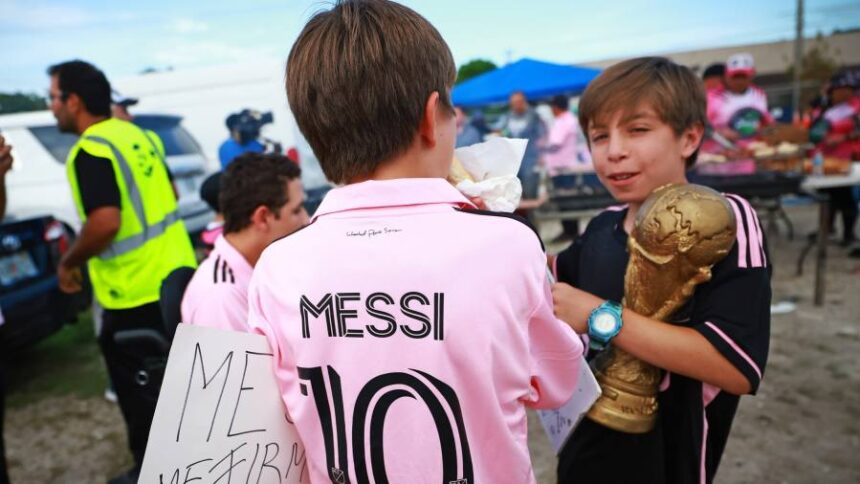Receive free Life & Arts updates
We’ll send you a myFT Daily Digest email rounding up the latest Life & Arts news every morning.
News that Crystal Palace have become the first football club in the Premier League to appoint a creative director was greeted by most of their fan base with a shrug. “Can he play at right back?” was among the more popular responses.
Kenny Annan-Jonathan, a “brand architect” who founded the sports marketing agency The Mailroom in 2017, has been enlisted to oversee apparel collections and fashion brand partnerships at the south London club.
He has previously worked with former Palace winger Wilfried Zaha, who recently left the club after a nine-season spell, as well as West Ham’s Michail Antonio and the sprinter Daryll Neita. Annan-Jonathan says he will create “products that go beyond typical sports team merch and grow the team’s fan base”. His first collection will debut in September.
Would you consider wearing Crystal Palace merch if you weren’t an Eagles fan? They finished mid-table last season and are relatively unknown as an international brand. Palace haven’t enjoyed huge fashionability since Ian Wright and Mark Bright were a dazzling goalscoring partnership.
But that was in the 1980s. And notwithstanding that I am a blood relative of a season ticket-holding, diehard member of the Eagles brethren, I imagine the club will struggle to become much more than a niche interest in an arena awash with bigger, more explosive brands.
Then again, the announcement comes at a time when football is cresting in popularity in all sorts of new unlikely ways. Who would have imagined a few years ago that the hottest football shirt this summer would be a candy-pink number from Inter Miami, a below-average Major League Soccer team?
Yet sales of the number 10 jersey have been frenzied since Lionel Messi signed in mid-July for the team co-owned by David Beckham. Fanatics, a company that tracks jersey sales, confirms that Messi has already surpassed stars such as American footballer Tom Brady and basketball player LeBron James in popularity as soccer has gained a foothold in the US consciousness.

Equally bizarre, Wrexham, currently in the fourth tier of England’s league system, have just completed a starry pre-season tour of the US on which they played Chelsea, LA Galaxy II and Manchester United (they lost 3-1).
Thanks to the fame of their actor owners Ryan Reynolds and Rob McElhenney, Wrexham have enjoyed the glow — and financial bounce — of a new fan base via a Disney+ series following their efforts to win promotion to the English Football League — the perfect underdog story, with Hollywood production. The team’s global popularity naturally has been accompanied by a huge spike in merch sales.
Wrexham might be one of the first clubs to galvanise a proper interest in league “soccer”, but it won’t be the last. News last week that Brady is partnering with Knighthead Capital Management to take a minority stake in Birmingham City could provide a similar fillip for a team that have hovered in the second tier of English football for more than a decade.
Brady says his interest was spurred by the club’s underdog appeal. Fans will be hoping the investment by a sports legend considered by many the greatest player in NFL history, will have the same Wrexham fairy-tale effect.
Crystal Palace are not owned by a Hollywood actor, nor possess a player like Messi who can trigger massive sales. But the club have been canny enough to recognise that, if the mood is right and the product sufficiently exciting, you might be able to shift club merch to buyers beyond the traditional fan.
My daughter couldn’t define a free kick if her life depended on it, but she has still amassed a fine collection of vintage shirts. According to brand agency Hatch Group, Google searches for “classic football shirt” have risen 32 per cent in the past year, while UK #footballshirt posts have had 17mn views on TikTok in the past four months alone.
Is this an overspill of the long-running trend for sportswear, the associated interest in the Fifa Women’s World Cup now under way or simply part of a cycle that routinely appropriates the football terrace for ideas? Or is there something deeper in our psyche that finds us, at a time of fractiousness and partisanship, seeking out, however nebulous, our “team”?
Certainly the new era of sport merchandising is banking on the idea that wearing a club’s kit is less a sign of season-ticket waving, religious fervour, and more a nod to the idea that the game represents a collective, feelgood mood. And from what I can see of Annan-Jonathan’s profile, he knows how to make things cool.
The refashioning of football, with fly-by-night supporters drifting in to buy a hoodie without having experienced the bitter chill of winter fixtures, will no doubt be looked on by sporting purists with disdain.
But if it brings money into clubs in lower divisions and stimulates a broader interest, it’s surely a win for fanatics and faddists alike. Besides, the traditionalists needn’t worry — it won’t be long before the cycle shifts and the real fans can reclaim the game for themselves.
Email Jo at jo.ellison@ft.com
Find out about our latest stories first — follow @ftweekend on Twitter








